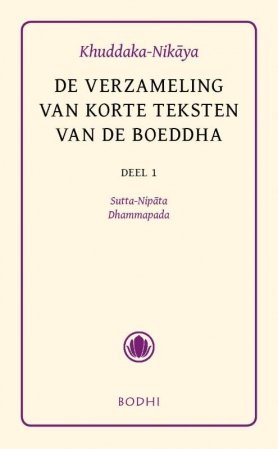This book contains the Dutch standard translation of two works that are part of the Khuddaka-Nikaya, ‘The Collection of Short Discourses of the Buddha’.
The Khuddaka-Nikaya is traditionally seen as – after the Digha, the Majjhima, the Samyutta and the Anguttara-Nikaya – the last of the five collections (nikayas) of the Sutta-Pitaka: the ‘basket’ (pitaka) of teachings (suttas) attributed to the historical Buddha and his main disciples.
The Sutta-Pitaka is part of the Pali-Canon together with the Vinaya-Pitaka (the ‘basket’ of the monastic rules) and the Abhidhamma-Pitaka (the ‘basket’ with detailed scholastic presentations of doctrinal material). Together they form the body of sacred texts of Theravada Buddhism. The Pali-Canon or Tipitaka (‘three baskets’) contain the oldest extant scriptures of the Buddhist tradition.
The Khuddaka-Nikaya is a heterogeneous collection of 15 works: Khuddaka-Patha, Dhammapada, Udana, Itivuttaka, Sutta-Nipata, Vimanavatthu, Petavatthu, Theragatha, Therigatha, Jataka Niddesa, Patisambhidamagga, Apadana, Buddhavamsa and Cariyapitaka. Some of these are among the most famous of Buddhist texts.
This book contains the complete translation of the Sutta-Nipata (‘Collection of Suttas’) and the Dhammapada (‘Words of Dhamma’). Both are considered among the oldest parts of the Pali Canon. In the Sutta-Nipata instructions are given how to live as a follower of the Buddha. A great variety of themes are addressed, such as the meditation on loving-kindness, death, old age, desire, the impermanence of body and property. The Dhammapada can also be characterised as a manual. It is a text that indicates how we can withdraw from the chains that bind us to the suffering, to the unsatisfactory existence in this world. The Dhammapada forms a poetic highlight in the Pali Canon and is rightly considered, along with, for example, the Tao Te Ching and the Upanishads, as one of the greatest wisdom books of world literature.
